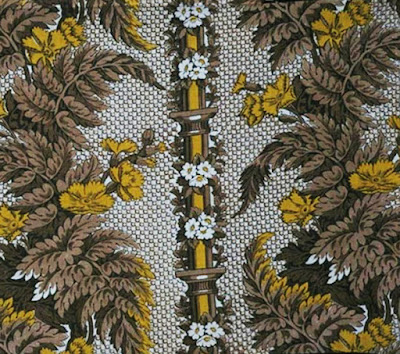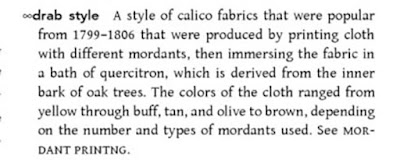Metropolitan Museum of Art, About 1840
Pansies (violas) printed in drab style using
a mordant printing method.
Above & below, two pillar prints dyed with Quercitron,
collection of the Victoria & Albert Museum
Early 19th century, about 1805.
Quercitron was quite useful, giving printers a
colorfast yellow as well as a way to print shades
from olive drab green through a variety of browns.
The print style became known as drab.
Another drab pillar print from England
probably done after Bancroft's patent expired.
The quercitron patent lasted until 1799 and temporarily profited Bancroft and his American brother Daniel as well as Captain John Paul Jones and other business partners, but Bancroft was never as good at business as he was at observation of the natural world and he died an Englishman in debt.
Detail of a quilt from the Shelburne Museum collection
Reading Walter Isaacson's biography of Benjamin Franklin I came across an account of Franklin's years in Europe as an agent of the rebellious American colonies. Franklin met Bancroft in England; the men had much in common and became friends. One major difference, however, was Franklin's commitment to the American revolution and Bancroft's Tory sentiments, which he kept a secret. As Franklin tried to woo France into supporting the rebellious Americans he enlisted Bancroft as secretary to the American Commission in Paris and counted on Bancroft to keep him informed as to British opinion and activities, in essence a spy.
But Franklin misjudged Bancroft who turned double
agent spying on the American Commission for Britain,
a betrayal discovered a century later.
Patchwork chair cover with a drab-style ruffle
from the collection of the D.A.R. Museum
Fairchild's Dictionary of Textiles tells us that drab style prints
were popular for less than a decade after the Bancroft patent expired.
Tied wholecloth quilt with a drab style floral probably
dating to after 1810.
1821 ad in Camden, South Carolina forg drab wools
That date range that is likely based on the research of Peter Floud of the Victoria and Albert Museum, who published "The Drab Style and the Designs of Daniel Goddard." in Connoisseur 139 (June 1957). But the date seems too narrow, particularly when dating quilts.
Quilt by Sarah Clark Ellis Ide (1822-1902),
estimated date 1845.
Sarah's mid-century quilts uses drab style prints in the
hexagons as well as the border.
Spencer Museum of Art at the University of Kansas
Drab style yellow and brown
Some would include prints with added madder reds in
drab style.
British frame quilt---1800-1830???
Cotton dress about 1830
Metropolitan Museum of Art
Winterthur Collection
There's a certain drab style print, a kind of gnarly tree with green & yellow
leaves that seems to be from the artists at the Bannister Hall printworks
in England.
One of their most popular was "Royal Oak."
A scrap of Royal Oak in an American quilt
from the 1840s--it may be a knock-off.
From the Hansen thesis
Archibald Rowan designed this drab style print about 1800
for his short-lived Delaware printing house.
Quilt by Zebiah Hewson
Philadelphia Museum of Art
Evidence that Pennsylvania printer John Hewson used quercitron.
The vegetation influenced by the Bannister Hall look.
http://quilt1812warandpiecing.blogspot.com/2012/06/drab-colors-quercitron.html
http://civilwarquilts.blogspot.com/2015/07/stars-in-time-warp-27-quercitron-and.html

























No comments:
Post a Comment